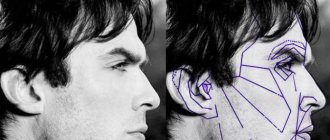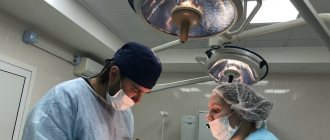A famous plastic surgeon traced the singer’s path from a typical African American to a disfigured white-skinned “doll”
Subscribe and read Express Newspaper in:
August 29, 2022 is a sad day for all fans of the legendary Michael Jackson. The “King” of pop music could have turned 60 today. Many are sure that he would have easily lived to old age if he had not been so obsessed with his own appearance and had not tormented himself with diets and plastic surgery.
Alexander Igorevich VDOVIN , told EG.RU readers about the changes the famous singer made to his appearance .
In his opinion, today no one can say for sure how many plastic surgeries were performed on Jackson. But if you compare photographs of the early period of his life with later ones, several facts become obvious.
Bad fall
It all started back in 1979, when Michael Jackson fell off the stage during a concert and broke his nose. This incident was the impetus for his never-ending pursuit of perfection. The first rhinoplasty turned out to be forced and not very successful, followed by a second - corrective one. It was after this that the first minor changes became visible on Michael’s face: the singer’s wide African nose became slightly narrower and smaller in size.
However, Jackson did not live with this appearance for long: in 1984, he took the first serious step towards his current state.
As a result of complete rhinoplasty, the tip was narrowed and the walls of the nose were shifted. Michael's face instantly transformed: his facial features became more subtle and expressive, and only his skin color spoke of his African-American origin. The new Michael Jackson instantly found himself at the peak of popularity. In the same year, he set a record for the number of Grammy awards (he received as many as 8!) for his legendary album “Thriller”. At this time, the public adores Michael, adores his moonwalk and his new nose.
Michael Jackson is the absolute record holder among Western stars for plastic surgery. He underwent more than 50 surgical interventions.
But it seems that Michael could not give up the idea that there is no limit to perfection. Already in 1985, he again went to a plastic surgeon - and he made his nose even narrower. Moreover, it became noticeable to the naked eye how the star’s skin color gradually brightened. Few people focused on this, citing the wonders of stage makeup. And there was no time for that, because all attention was still focused on his work, and not on scandals and plastic transformations. Jackson's new song "We are the world" remains at the top of the charts and receives all possible awards. Jackson receives the unspoken title of King of Pop.
Rhinoplasty
Michael personally admitted on the pages of his autobiography that he changed the shape of his nose and made a “dimple” on his chin. Then the singer claimed that the operation was a necessary measure to correct the septum after a fall during rehearsals. But I'm sure the reason is different: Jackson has been dissatisfied with his appearance since adolescence.
“Thank you” to his father, who instilled complexes in the boy. They say that the artist had dysmorphophobia - a psychological illness in which a person suffers due to any shortcomings and imperfections in appearance.
During the first operation, doctors narrowed the bridge of his nose, but this was not enough for Jackson. As a result, Michael had five rhinoplasties, and his naturally wide nose of a typical African American turned into something shapeless and scarred. It got to the point where he needed a cartilage transplant because his nose began to rot and collapsed. To do this I had to take part of the rib.
1980 Michael Jackson is still black. Source: GLOBAL LOOK PRESS
Scalpel addiction
The passion for surgical interventions became Michael's drug. Two years later, in 1987, the pop idol finally went off the rails: rhinoplasty made Jackson’s nose even thinner, the singer enlarged his cheekbones by inserting facial implants into them, raised the corners of his eyebrows using endoscopic technology and whitened his skin to the limit. Jackson himself explained the reason for his “lightening” by a skin disease called vitiligo. That is, the only way to avoid a total violation of the pigmentation of the face and body for the singer was a radical change in skin color. By the way, according to one version, it was numerous plastic surgeries that caused Jackson’s skin pigmentation. Allegedly, because of this disease, the singer even has to avoid direct sunlight, wear dark glasses and a hat. However, whether this is true or not is unknown, because Michael’s doctors are obliged to maintain medical confidentiality.
Contour plastic
Already at that time (early 2000s), operations to change the shape of the face began to gain popularity. For this purpose, silicone implants and fillers were used, which were injected into the chin and cheekbones. This was done to Jackson. The result of this plastic surgery was an unnaturally wide face and deep depressions. Coincidentally, at that time in the life of the pop star there were several lawsuits at once, so it is not surprising that Michael became haggard, lost weight and began to look bad. He tried to correct this with makeup.
They say that the singer always dreamed of a “protruding” chin, so the implant was inserted there too, and the seam in the middle of the chin was healed - hence the dimple. All together it looked terrible, coupled with thin lips, unnatural shape of cheekbones and chin.
Michael Jackson: date of birth, height, weight and plastic surgery
| Date of birth/place of birth | August 29, 1958 (died June 25, 2009) / USA, Indiana, Gary. |
| Occupation | American singer, producer, composer, choreographer, entrepreneur. |
| Height Weight | 175 cm / 63 kg. |
| Confirmed plastic surgeries | Rhinoplasty, mentoplasty. |
| Alleged plastic surgery | Blepharoplasty, contour plastic surgery. |
What did Michael Jackson really do with his face?
There are so many myths about the changes in Michael Jackson’s appearance—what kind of operations are attributed to him. Even some “experts” sometimes voice their “authoritative opinion”, telling us about the many changes on his face. There were changes, of course, but they basically had nothing to do with plastic surgery. Michael Jackson is not the only one on whose face a lot of surgical and cosmetic interventions are found - as if no one changes with age or with the help of makeup, and weight loss has no effect on facial features. Well, no one seems to realize the importance of light and angle when it comes to photographs. However, it is Jackson who is constantly diagnosed with body dysmorphic disorder and is told that he has disfigured himself with plastic surgery. Michael, of course, really wasn’t happy with his appearance, but he didn’t have any mental disorder. And the fact that he allegedly mutilated himself was actively suggested by the media for many years, happily publishing the most unfortunate photographs and fantasizing about operations. But first things first.
"Mutilated" Michael Jackson, 2007.
Michael Jackson's last photo shoot, 2007
Let's start with the fact that Michael had two autoimmune diseases: vitiligo and lupus erythematosus
Vitiligo is a disease accompanied by the loss of melanocytes in the skin and the formation of foci of skin depigmentation of various sizes. The cause of the disease is unknown, but genetic and immune mechanisms are likely to be involved. The diagnosis is usually obvious by examining the skin. Treatments often include topical corticosteroids (often combined with calcipotriene), calcineurin inhibitors (tacrolimus and pimecrolimus), and narrowband UVB therapy or psoralen with UVA therapy. Common rashes may benefit from narrowband UVB therapy. In cases of severe widespread loss of pigment, permanent depigmentation (bleaching) of the remaining spots of normal skin can be performed with hydroquinone monobenzyl ether.
Debbie Rowe (a nurse) said it would be difficult for anyone to cope with even one of Jackson's illnesses, but he had to cope with all of them, and in front of the public: “He was very shy, so for him to appear in public with all these problems was very difficult . Rowe said Michael was ashamed of his condition. According to her, Michael didn’t trust anyone at all; he didn’t even want to burden his mother with details about his condition.
- Did he consider himself disfigured?
- Yes. He worried that people would see his illness and physical limitations before his work.
Vitiligo can have very different forms and varying degrees of damage.
Contrary to what many people think, Michael Jackson is not the only one who became almost completely white-skinned as a result of this disease - the severity of vitiligo can vary greatly. When Michael's light spots first started to appear, they were made up to match his dark skin color; and when the condition worsened as much as possible and there were too many light areas, that’s when Michael “became white-skinned,” because now it made more sense to use light makeup. His makeup artist talks about it in the video below. You will also hear stories of other people affected by this disease, and find out what Michael himself said about it. And of course, he used special whitening creams for vitiligo patients.
You can turn on Russian subtitles.
Systemic lupus erythematosus (SLE, Libman-Sachs disease) (Latin lupus erythematodes, English systemic lupus erythematosus) is a diffuse disease of connective tissue, characterized by systemic immunocomplex damage to connective tissue and its derivatives, with damage to microcirculatory vessels. A systemic autoimmune disease in which antibodies produced by the human immune system damage the DNA of healthy cells, primarily damaging connective tissue with the obligatory presence of a vascular component. Lupus is difficult to diagnose and can masquerade as other diseases. One of the characteristic signs of lupus is a rash on the face, similar in shape to butterfly wings . True, it does not occur in everyone - and in general there are no two patients whose manifestations of this disease would be the same. Other symptoms of systemic lupus erythematosus may include: joint pain and swelling, unexplained fever, deformed and brittle nails, hair and eyebrow loss, muscle or chest pain when taking a deep breath, sores in the mouth and nose, pale skin - especially on the hands and legs, increased sensitivity to sunlight, swelling of the legs and face, impaired appetite and sleep, chronic fatigue . Symptoms may come and go, and there may be more or less of them.
Michael at one time (in the 80s) could see a butterfly-shaped rash on his face, swelling of the face and loss of eyebrows. In later years he experienced problems with his nails and swelling of his joints. It is also known that he suffered from some other characteristic symptoms: loss of appetite and sleep (which, of course, had other causes), fever... As for pallor and sensitivity to light, given that he also had vitiligo, this and so it goes without saying, but the pallor of his hands was really painful. Lupus also impairs the healing of skin lesions - painful keloid scars , which became Michael Jackson's biggest problem.
A keloid scar is the most difficult type of scar to treat and the most unpleasant for the patient. It can grow significantly, affecting healthy tissue. Previously, there was a division of keloids into true, which arise spontaneously, and false, which arise after injury. However, it was later proven that in the case of a true keloid there was still microtrauma. Such scars are bright pink, sometimes reddish, itchy (especially at night), cause extremely unpleasant sensations, and rise significantly above the surface of the skin.
Accident
In 1984 , while filming a Pepsi commercial, Jackson suffered a very serious burn to his scalp, as a result of which he suffered pain for the rest of his life - not only from the burn itself, which resulted in painful keloid scars , but also from treatment begun in 1993 year, which was aimed at reducing the consequences, but was not successful - lupus interfered with the healing of the skin, and the situation only worsened. Once upon a time there came a time (late 90s) when Michael had to wear wigs, which, along with whitened skin and weight loss, at first glance, greatly changed his appearance.
Debbie Rowe said the burn left Michael with scars on his skin and developed keloids, which are extremely painful. For Jackson, they started in the middle of his skull and ran back to the top of his head. He didn't want to wear a hairpiece, so they went for weekly scalp stretching treatments. Keloid tissue is very dense and regular injections are required to treat this condition. In some cases, an air gun is used for treatment.
“It’s terribly painful,” Rowe said. “When the medicine is injected, you can hear the skin bursting.”
"Dr. Sasaki placed an implant under Jackson's scalp that would stretch the skin."
“So it expands and stretches the skin?” - "Yes. It hurts like hell. This requires the use of painkillers. Sometimes, after cutting out the keloid, an even larger keloid will form. The goal was to reduce the problem to just one keloid, but they failed. The fabrics fell apart in '96 or '97. Because of lupus, my skin was not strong enough. As a result, the keloids became even thicker and larger.”
Consequences of the burn, 1984
Debbie Rowe on Michael Jackson's treatment
Plastic surgery
Of the plastic surgeries, Jackson only performed rhinoplasty (surgery to change the shape of the nose), subsequently, due to lupus, he developed scars that made breathing difficult, as evidenced by Debbie Rowe. It is clear that after a maximum of several aesthetic surgeries, further changes in the appearance of his nose were caused by the elimination of unpleasant consequences. In the mid-80s, a small dimple was added to his chin. That's all.
Dr. Strick: By and large, he was a healthy guy. Lupus is an autoimmune disease, and it affected his skin, destroying part of the skin on his nose. Plastic surgery on the nose was actually (note: later) reconstructive to restore a normal appearance.
Question: So all these nasal reconstructions you talk about were the result of treatment for lupus?
Dr. Strick: The first surgery (reconstructive) was an attempt to repair the tissue—the destruction that had happened there in the skin—but it didn't work well. All subsequent attempts, in my opinion, were attempts to still do it right.
Before and after adding a dimple on the chin.
Over the years, Michael became white-skinned due to vitiligo, in recent years he has lost a lot of weight, especially since with age the fat layer of the face naturally thins, and coupled with weight loss, the effect was maximum. There were no fillers or implants in his face - Michael always had very expressive cheekbones and a jawline, which is clearly visible in many early photographs, where he is at a lower weight, but is most often compared either with photographs of a very young Michael, where he still has not even fully formed facial features, or with photographs from the “BAD” era, when there was swelling on the face due to lupus. Light and angle, of course, are generally not taken into account, as is makeup.
While claiming that Jackson tried to get rid of all signs of his race (some are still convinced that he somehow magically bleached his skin), including large lips, people refer to photographs of Michael at a young age, which is completely unreasonable.
Firstly, the lips look larger against the backdrop of the still insufficiently grown skull bones and are as voluminous as possible due to age.
Lip aging begins after 25 years. The aging of the lips is particularly influenced by the activity of the facial and masticatory muscles, the preservation or absence of teeth, and the characteristics of articulation. However, most of all, age-related changes are associated with degenerative processes in tissues; they also depend on the type of constitution. Over time, muscle function and tone weaken, and their density and volume decrease. A decrease in muscle motor activity impoverishes facial expressions and plastic expressiveness of the face, which becomes mask-like. The orbicularis oris muscle atrophies (especially in the upper lip), the lips lengthen, become thin, wrinkle due to volume redistribution (especially in the lateral part of the lip), the mucous membrane becomes thinner, the “Cupid’s line” smoothes out, and the white ridge disappears.
All this can be observed in the lips of Michael’s mother.
Secondly, not only with the help of makeup, but also with the help of lighting and angle, you can achieve a certain visual effect. Pay attention to the collage of photos from one photo shoot. In both photos on the right, the lips look much fuller.
And if you are careful, you will see that Jackson’s lips have never been particularly voluminous.
We also take into account the makeup that Jackson was forced to wear due to vitiligo, and which, unfortunately, was not always successful - especially since the 90s, when they began to make him up to match his white skin color, actively using contouring and lipstick.
As mentioned above, Jackson has always had expressive facial features. It is not so easy to find the most similar angles with the same lighting, but you can still try to make sufficiently adequate photo comparisons so that people can be convinced that Jackson’s “hundreds of plastic surgeries” are a myth; unless, of course, they look with even the slightest idea of the influence of age, makeup, light and angle on appearance, without expecting to see exactly identical nuances.
The difference in the photos on the left and right is the makeup - in the photos on the right, the eyes are given a rounder shape, and the nose appears narrower due to lighting and contouring.
Amazing work from a fan, clearly demonstrating that the changes in Michael's appearance were not as significant as they might seem at first glance.
Why did Jackson often wear a medical mask over his face?
Michael himself said that he once put on a mask after dental surgery, and he liked it. For a person who is always in the public eye, whose appearance is constantly examined and discussed, this is a real find. Remember about his illnesses, which entail aesthetic imperfections, and then this fact will no longer seem strange.
Share link:
Liked this:
Like
Cutting-edge plastic surgery
It involves an absolute study of the client’s state in psychological and physical terms, and clarification of his goals. Perhaps large sums could help doctors forget about the Hippocratic Oath. “Before” and “after” photographs do not allow you to recognize the once sweet person.
The image of Michael Jackson gives a chance to clearly understand that the boundaries of what is reasonable are necessary in the pursuit of improving one’s own appearance and searching for a personal ideal.
Rhinoplasty can not only transform a person’s appearance beyond recognition, but also lead to irreversible damage. Today's advances in plastic rhinosurgery can lead to the restoration of the nose when it is completely absent, with the replacement of tissue and osteochondral structures through implants and epidermal transplantation.
Is it really necessary to strive to mutilate and torture yourself? In this pursuit, the main thing is to stop in time, otherwise you can be lost, useless to anyone.
Why did Michael Jackson have surgery?
According to psychologists, the famous singer was not just interested in changing his appearance.
He probably suffered from a special mental disorder - dysmorphophobia. With this disease, a person worries very much about the slightest physical defects. Dissatisfaction with one's appearance can be expressed in depression, masochism and even suicide attempts. According to Jackson himself, his father often bullied him and his brothers. He called them names, beat them and mocked them for their appearance flaws. Children's complexes could have given rise to the singer's craving for external changes. By the way, according to some reports, contrary to widespread rumors, Jackson did not undergo skin whitening operations. He simply suffered from the disease vitiligo, which results in the appearance of white spots on the skin. The singer also had lupus, the external manifestations of which consisted of a rash on the face. To get rid of diseases, Jackson took many medications that cause skin lightening. In addition, he constantly used light makeup to mask the spots.
Color of the skin
The press harped on the fact that the “king” of pop music had suddenly “turned white.” It was rumored that to achieve this, his skin was whitened with a special potent drug - glutathione. However, after the singer’s death, it turned out that the cause of these metamorphoses was vitiligo, a disorder of skin pigmentation.
To hide the spots, Michael was given a huge layer of makeup and prescribed a large number of powerful medications. This, of course, could not but affect his health. As a result, his skin turned sallow and Jackson was forced to wear a mask.
Three years before the singer’s death, the artist was diagnosed with skin cancer. They even said that Michael received a full skin transplant, but this is hard to believe. He underwent several operations aimed at destroying cancer cells, but in the end he was tired of fighting the disease. Surprisingly, Jackson did not die from cancer. His heart simply stopped beating, and this, according to doctors, had nothing to do with skin cancer.
Many celebrities trust their faces to plastic surgeon Alexander Vdovin
How did Michael Jackson change throughout his life?
How did it happen that a handsome black boy turned into a frightening wax figure with a porcelain face while still alive? There are many versions - a morbid fascination with plastic surgery, psychological problems, illnesses. But the fact that Jackson hated his appearance, body, face, even skin color has long been a known fact. He rejected with disgust everything that nature gave him. He fought desperately with her and she seemed to repay him in kind.
Michael's fans watched in horror as their idol's appearance changed every year. Over time, he began to look less and less like the young, black, charismatic singer with the voluminous, curly Afro hair they had known during the rise of his stellar career. Caustic remarks, jokes and outright mockery were directed at the singer even after his death.











